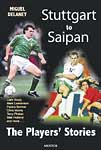 The Players' Stories
The Players' Stories
by Miguel Delaney
Mentor, €16.99
Reviewed by Paul Doyle
From WSC 291 May 2011
There is a touch of Fawlty Towers about the Republic of Ireland's golden years. Not only because the main character was a lanky and rude galoot with Sybil-esque single-mindedness, nor merely because the Manuels of the FAI see to it that the country's football history often reads like the script of a hit sitcom, but also because there have been so many reruns that you wonder if there is any point in taking in another.
This book begins with the Jack Charlton era – which has already been the subject of innumerable DVDs, TV shows, players' autobiographies and after-dinner speeches – and ends with the 2002 World Cup and that Roy Keane/Mick McCarthy contretemps that you may have read about one or two million times before. Is there really any value, then, in a book based around interviews with a handful of ex-players from an already amply documented 16-year period? It is testament to the skill and cleverness of author Miguel Delaney that the answer in this case is an emphatic yes.
Delaney has assembled a diverse cast of interviewees and makes a virtue out of the fact that they include neither the managers nor virtually any of the star players of the time. Instead of O'Learys, Houghtons, Keanes or Duffs, we get to hear the tales of footballers such as Chris Morris (full-back turned Cornish pasty tycoon), Tony Galvin (rampaging left-winger who delayed the start of his professional career so he could complete a degree in Russian) and Terry Phelan (Crazy Gang member turned globe-trotting coach).
All are articulate and independent-minded, meaning their reminiscences are devoid of cliche and platitudes. As such, they complement the unpretentious, clear-sighted contextualising of the author. We get the japes and anecdotes (and not the same ones we've heard hundreds of time before, but fresh ones such as how Toto Schillaci inveigled Morris into performing a strip-tease on the pitch after the Italy v Ireland quarter-final in 1990, or how Charlton reacted with horror when he discovered during Euro 88 that the FAI had unwittingly booked the team into a nudist camp). But we also get interesting appraisals of the managers' methods that go way beyond repeating that Charlton put opponents under pressure and let his players have a drink (Packie Bonner is particularly good on Charlton's tactical shrewdness).
Matching the tone that Delaney instils, the two most famous names to whom the author speaks – Mark Lawrenson and Liam Brady – are also insightful and fair, both when describing the set-up before and during Charlton and when shedding new light on questions that many have asked down the years: Just how Irish is Lawrenson? How much did Brady and Charlton hate each other? Is Eamon Dunphy a charlatan?
The book does not dwell on minutiae nor purport to offer the definitive verdict on, for example, the Saipan incident, but it does allow each of the players interviewed to veer off into descriptions of their non-international career and post-playing activities. That this never comes across as irrelevant filler reflects Delaney's deftness and the fact that successful teams, like successful books, are happy amalgams of an array of singular stories.